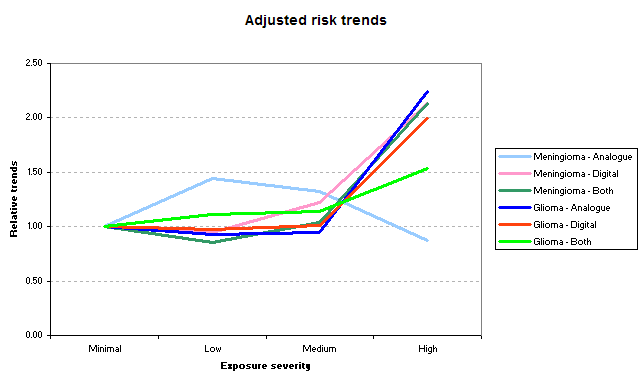 |
 |
|
 |
 |
About Us | Contact |
|
|
18/05/2010 - Further analysis of INTERPHONE dataWe have now fully read the published data on the first of the pooled INTERPHONE results. Recent coverage in the Daily Mail, the Times, the Telegraph and the Scotsman have announced that the paper demonstrates clear brain tumour risks from long term usage. Some other media, including the BBC, have reported almost opposite conclusions. We may not draw those conclusions with quite such certainty, but the pooled data is strikingly consistent, and is certainly indicative of a long term risk. What is more remarkable is that this risk appears despite the severe flaws in the study protocol, the majority of which would both underestimate and dilute any present risk. The more severe protocol flaws, in no particular order1. No proper assessment of exposure to DECT, WiFi, or other forms of potentially relevant RF exposure For the sake of simplicity, we will only consider DECT cordless phones to be relevant as that is the only form of exposure that involves holding a transmitter next to the user's head, in much the same way as they would with a mobile phone. It is also relevant that the base unit of almost all DECT models is permanently emitting at a lower level, so if a "control" participant users his DECT phone as much as a "case" participant uses his mobile, the control user is likely to have a similar brain exposure and higher overall exposure due to the base unit. DECT handsets are less powerful than a mobile phone (0.25 watts c.f. 1 watt or 2 watts) but they do not have adaptive power control (mobile handsets can control their output power over a range 1000:1 and work at the lowest level to maintain the call) and so, when a base-station is fairly close by, a mobile phone will often work at a lower peak transmit power than a DECT cordless phone. DECT phones were launched in 1992 and by the mid 1990s were becoming increasingly popular as they worked better than the earlier analogue cordless phones and conversations were much more secure.
By the late 1990s, when the protocol for the INTERPHONE project was developed and published (1997-1999), DECT phones were already becoming most people's choice of home phone in much of Europe. In 1999 BT Cellnet launched a dual DECT & GSM service combining mobile and cordless functions. By the end of 2000, some 60 million DECT systems had been sold in Europe. However, despite calls at the time for DECT use to be taken into account, the INTERPHONE protocol did not include DECT. As a result, the fact that there is no separation in the data based on DECT exposure creates a very large confounder in the study data. If someone uses their cordless phone for most of their calls, only saving the mobile for rare occasions on the move, they may well have a very high equivalent exposure but be classified as very low usage within the study protocol. There was no effort to match controls to cases on digital cordless phone usage (one way of controlling for the confounder), so this is likely to have injected a lot of "random noise" into the final pooled data, diluting any observable patterns by creating spuriously high and low data points. 2. Latency periods of brain tumours Our understanding is that the mean latency periods (time between "causative" exposure and the initiation of the tumour) of the tumours studied in this paper are 20 to 25 years, with standard deviations of +/- 5 years. As a result, the largest likely proportion of tumours that would appear within about the first 12 years of phone usage is 2-3% of the final number of tumours actually associated to mobile phone usage (if the association is real). This means that to see any statistically signifcant, even in the 10+ year category (although there is no defined end to the "+", almost users had used their phone for less than 12 years), is potentially very concerning. Either the risk is an artefact, caused by some confounding or bias issue, or it will be the tip of a much larger iceberg. 3. Recall bias The only bias that is likely to be able to cause an artefactual (non-genuine) increased in long term brain tumour risk is recall bias. It is possible if users heavily underestimated their phone usage that the actual risk is lower than stated in the paper (although this is a bias that will reduce towards no risk, it cannot explain the protective effects found elsewhere). However, the INTERPHONE group published a paper to assess this possibility, and found that the heaviest users had a tendency to overestimate their phone use. As a result, any increased risk found is for a usage level lower than that reported in the paper, thus again leading the results themselves to underestimate the risk in the heaviest user category. Comments in the press that recall bias can explain the findings in the paper are therefore implausible. 4. Definition of regular user The Interphone protocol defined a "regular phone user" as someone who used their phone at least once per week over a period of 6 months or more! This is a very lax definition of "regular" usage, especially when many people now use their phone for over an hour on a typical day. As such, there will be a lot of variation between the intensity of usage across the range of regular users. In our analysis below, we have focused on cumulative hours of phone use as a) that seems the most appropriate metric for comparing overall exposure to effect, and b) it goes some way towards mitigating the effect of this confounder. Our analysis of the dataWe can see little evidence anywhere that there is any risk for short term, light usage. This is neither surprising, nor reassuring, as it would not be expected to detect any increase in risk within the first 10 years, and certainly the first 5 years, of phone usage. However, this does not necessarily mean that 5 years of use does not pose a risk, as it could be up to 30 years before the full risk from that 5 years of usage has been realised (i.e. 25 years after the user ceased to use his phone). In the tables of data themselves, the majority of odds ratios across all tables of data are below 1, and in some cases significantly so, but as the authors themselves had stated, this is due to a general underestimation of risk caused by the flaws in the study design. This makes direct comparison of the control data to any of the subsets of case data almost meaningless as the control data shows an artefactually "elevated" value of 1. This makes it very difficult, unless the increase in risk in the paper is very large, to have the resolving power to detect a significant increase. For heavy usage, the picture is very different, and is consistently showing concerning indications of an increased brain tumour risk. As the flaws make the precise numbers relatively meaningless, we believe it is still important to attempt to analyse the numbers for any evidence of patterns and trends. Because of flaw 5 above, we have restricted our detailed analysis to the cumulative hours of phone usage in Appendix table 3. This table had 6 distinct separate subsets of data: The two tumour types (meningioma and glioma), each broken down into "only analogue phone users", "only digital phone users" and "both types of phone, or unknown". Each of these was further broken down into cumulative hours of use. As the ORs of any of the cases seem to have a baseline risk of around 0.8 (i.e. a protective effect), we have normalised the data, taking the bottom two exposure severities (< 5 hours and 5 - 114.9 hours usage) as an OR equivalent of 1.0, or no increased risk. From that, we plotted the other points accordingly - we are aware that this makes the numbers very hard to draw precise conclusions from, but the purpose was to visually ascertain whether the data appeared to have any form of consistent pattern, in a a way that partially controls for the flaws in the study designs. The graph seems to speak for itself:  Normalised INTERPHONE data from Table 3 in Appendix 1 What the graph does say, and what it does not sayThe graph does not say that long term usage of a mobile phone gives a increase in brain tumour risk of 50% that we can safely say is causally associated with mobile phone usage. The mathematical adjustment we used is by its nature very crude, and robust conclusions simply cannot be drawn from our analyis. However, what it does say is that for five out of the six datasets of actual time spent on the phone, brain tumour risk stays relatively constant until the most severe exposure levels, at which point it sharply rises. For all but one set of data to show exactly the same trend by random chance is statistically completely implausible. If the biases and confounders cannot cause this pattern (and, according to published research, the only identified one where this pattern would "fit" showed the opposite effect) the most logical remaining explanation is that the association is not an artefact. Combining the different exposure sources produces the following table of normalised odds ratios:
Regardless of the limitations of the method of analysis, it is a strikingly consistent set of data overall, and clearly indicates a risk that increases with usage. Our conclusions
As a result, it is hard to conclude anything from the data other than the fact it is beginning to point towards a genuine long term association between mobile phone use and brain tumours. Despite the obvious flaws in the study skewing the data towards showing a protective effect, the long term pooled usage still showed a statistically significant 40% increase in risk of gliomas, one of the quickest killing forms of malignant cancer, but also a near significant increase in risk for meningiomas. It is without question that more research must urgently be done collecting more data on long term use (ideally with categories over 12, 15 and even over 20 years of usage, and higher cumulative hours data), as if the latency period for these tumours from other sources applies also to mobile phone exposure, we could be seeing the tip of the iceberg. If we really are only seeing the first 3 or 4% of eventual tumours, the real risk could easily be 30 times higher than the data has shown so far, and we will have no way of knowing until more comprehensive research is completed. Other coverage of this issue
This page has links to content that requires a .pdf reader such as |



